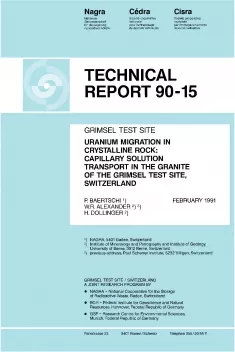
Technical Report NTB 90-15
Grimsel Test SiteUranium migration in crystalline rock:Capillary solution transport in the granite of the Grimsel Test Site
The formation of U-containing fluorescent surface exudations in the galleries of the Grimsel Test Site (GTS) have been studied. Mineralogical, chemical and radiochemical analyses were carried out on the exudations and the near-surface rock (2 drill cores). The capillary transport of pore water to the surface was studied by three small in-situ experiments: a) vacuum extraction of pore water, b) surface evaporation under controlled conditions and c) infiltration of water into the granite.
Pore water extracted from fluorescent zones is similar to other GTSgroundwaters but with a much higher U content of up to 1 mg/l. This U is probably mobilized from finely dispersed U minerals in the waterconducting microfractures of the granite near the tunnel wall by the action of dissolved air. Transport to the tunnel wall through an increasingly unsaturated zone is caused by capillary forces and by surface evaporation from very narrow, water-filled microfractures. Water is also sucked into the unsaturated rock at the tunnel wall with negative pressures of 0.5 – 1 bar.
Chemical and radiochemical analyses of the near-surface granite indicate some co-precipitation of U with Fe2O3(H2O)x from the aerated pore-water during formation of the fluorescent surface layer. Unlike U, Th and Ra appear immobile in the near-surface rock.
Fluorescent zones indicate geochemical conditions which may lead to high mobility and transport of U and possibly of other actinide elements. Such conditions are associated with unsaturated regions close to ventilated rock surfaces and are therefore probably of little direct significance to the safety assessment of deep radioactive waste repositories. They do, however, give indications of the physical and chemical perturbations involved in repository construction and the subsequent operational phase of the repository.
